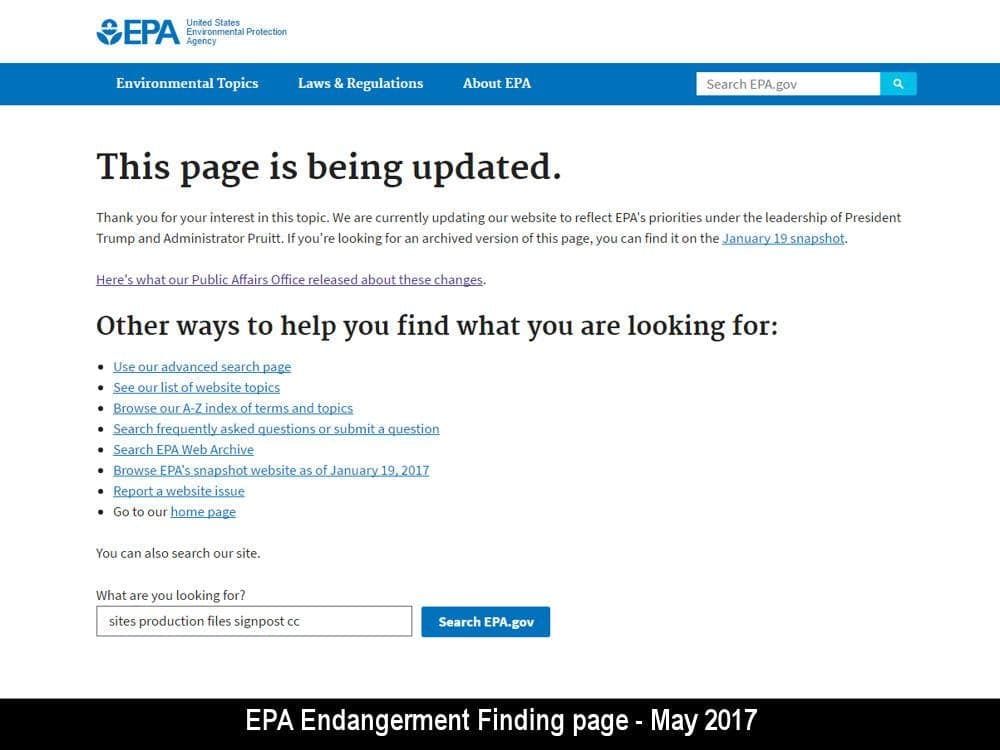President Trump’s Presidential Executive Order on Promoting Energy Independence and Economic Growth instructs the EPA Administrator to “review and, if appropriate, as soon as practicable, take lawful action to suspend, revise, or rescind, as appropriate and consistent with law, the "Legal Memorandum Accompanying Clean Power Plan for Certain Issues," which was published in conjunction with the Clean Power Plan.”
The legal underpinnings for the Clean Power Plan(CPP) are: the April 2, 2007 US Supreme Court ruling that CO2 is a pollutant under the Clean Air Act; and, the EPA December 5, 2009 Endangerment Finding and Cause or Contribute Finding for greenhouse gases. This Endangerment Finding requires that EPA establish and promulgate a National Ambient Air Quality Standard (NAAQS) for the greenhouse gases which are the sources of the endangerment. This NAAQS has not been issued in the 7+ years since the Endangerment Finding; and, an internet search provides no links to any documentation of EPA activity to develop and promulgate this NAAQS.
Several sources have called for reconsideration of the EPA Endangerment Finding:
- Manhattan Contrarian
- ICECAP
- Competitive Enterprise Institute (CEI) and the Concerned Household Electricity Consumers Council (CHECC)
(HT: The Science and Environment Policy Project www.sepp.org)
EPA Administrator Scott Pruitt questions whether EPA has either the authority under the Clean Air Act or the ability, as currently structured and staffed, to regulate CO2 emissions. Congress considered and explicitly rejected including CO2 as a criteria pollutant when considering the Clean Air Act and its later amendments.
Democrat members of the US Senate have written to Administrator Pruitt, expressing their concerns about the future of the CPP; and, demanding responses from EPA regarding EPA decisions relating to the future of the CPP.
It is becoming increasingly clear that the effort to rescind the CPP will be challenged as long as the Endangerment Finding remains in place. Therefore, as difficult as it might appear, the Endangerment Finding must be challenged; and, either substantially revised or rescinded.
Recent climate research suggests that climate sensitivity to increased atmospheric CO2 concentrations is at the lower end of the range of values estimated by the IPCC, or even below that range. These results suggest that humanity is not as “endangered” as the studies used to support the 2009 EPA Endangerment Finding indicated. Therefore, it appears that the first approach to revising or rescinding the EPA Endangerment Finding should be a thorough review of the recent climate sensitivity research by non-EPA “tiger teams”, to determine whether the “endangerment” identified by EPA is real and of sufficient magnitude to justify regulatory programs such as the CPP.
Absent the requirements of the CPP, electric utilities and non-utility power plant owners and the state utility commissions which regulate them would be free to continue to pursue expanded natural gas combined-cycle power plant and renewable generation options, applying Best Available Current Technology, consistent with maintaining system reliability and controlling consumer energy costs.
